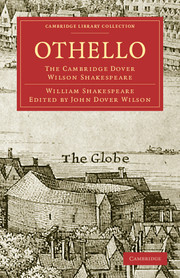THE STAGE HISTORY
Published online by Cambridge University Press: 07 September 2010
Summary
Popularity on the stage has marked the play from the outset. Performances at Court are attested as early as I November 1604 at Whitehall; again in 1612–13 during the festivities gracing the marriage of the Princess Elizabeth to the Elector Palatine; in 1636 it was presented at Hampton Court. In April 1610 a foreign visitor saw it at the Globe, and it was staged in Oxford in September; in 1629 and 1635 it was shown at Blackfriars Theatre. In this period Burbage and Swanston were Othello and Taylor was Iago. After the Restoration Pepys saw ‘the Moor of Venice’ at the Cockpit on 11 October 1660 with Burt as the Moor; on 8 December it was shown at the Theatre, formerly a tennis-court, in Vere Street. Pepys saw the play again on 6 February 1669, at the six-year old Theatre Royal, Drury Lane, Burt once more Othello; Hart was Cassio, Mohun Iago, and Mrs Hughes (probably the first woman ever seen on the stage) Desdemona. Clun, wrote Pepys, had been a much better Iago earlier, and Burt he thought poorer than before. Actually Burt was superseded soon by Hart, while Kynaston took on Cassio. In 1674 and 1675, after the Duke's and King's companies had combined, in 1683 and 1684, royalty witnessed the play at Drury Lane; and again in Whitehall in 1686.
Only seven years in the eighteenth century have left us no notice of an Othello in London.
- Type
- Chapter
- Information
- OthelloThe Cambridge Dover Wilson Shakespeare, pp. lvii - lxviiiPublisher: Cambridge University PressPrint publication year: 2009First published in: 1957



